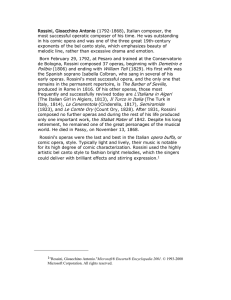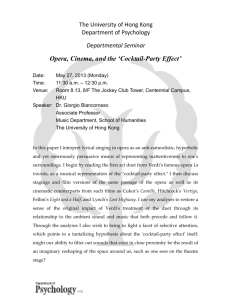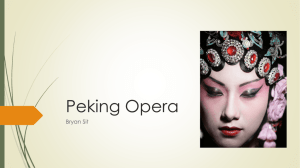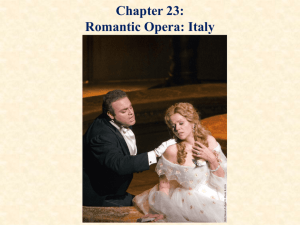Music 320 - Nineteenth Century Opera to 1850 Italy
advertisement
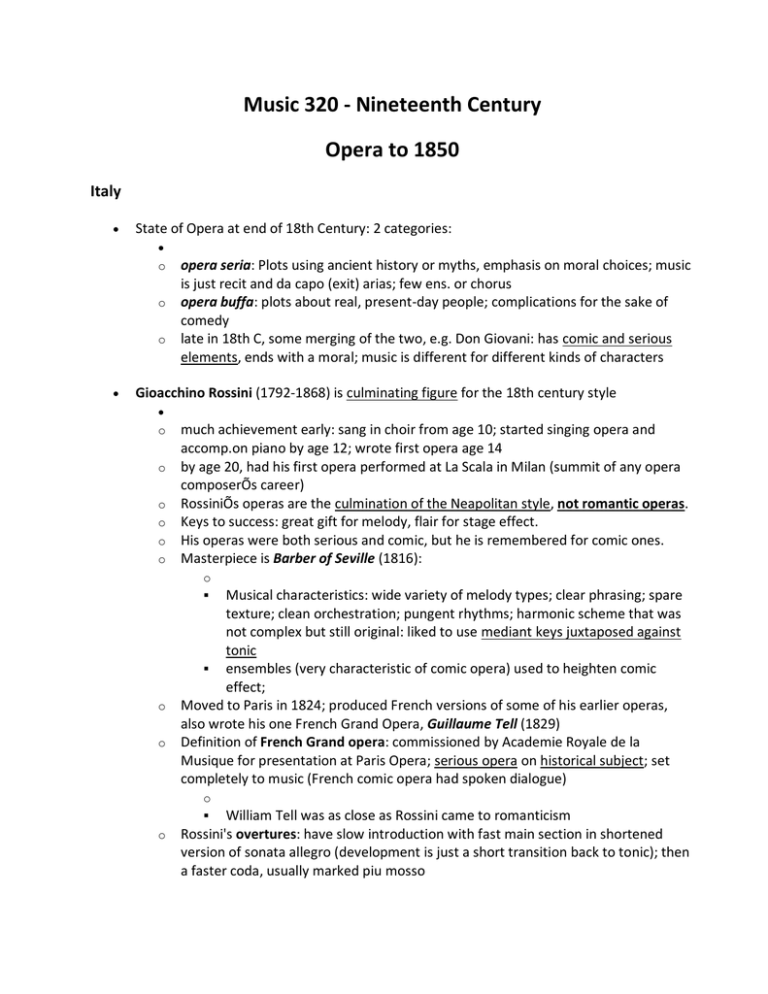
Music 320 - Nineteenth Century Opera to 1850 Italy State of Opera at end of 18th Century: 2 categories: o opera seria: Plots using ancient history or myths, emphasis on moral choices; music is just recit and da capo (exit) arias; few ens. or chorus o opera buffa: plots about real, present-day people; complications for the sake of comedy o late in 18th C, some merging of the two, e.g. Don Giovani: has comic and serious elements, ends with a moral; music is different for different kinds of characters Gioacchino Rossini (1792-1868) is culminating figure for the 18th century style o o o o o o much achievement early: sang in choir from age 10; started singing opera and accomp.on piano by age 12; wrote first opera age 14 by age 20, had his first opera performed at La Scala in Milan (summit of any opera composerÕs career) RossiniÕs operas are the culmination of the Neapolitan style, not romantic operas. Keys to success: great gift for melody, flair for stage effect. His operas were both serious and comic, but he is remembered for comic ones. Masterpiece is Barber of Seville (1816): o Musical characteristics: wide variety of melody types; clear phrasing; spare texture; clean orchestration; pungent rhythms; harmonic scheme that was not complex but still original: liked to use mediant keys juxtaposed against tonic ensembles (very characteristic of comic opera) used to heighten comic effect; o Moved to Paris in 1824; produced French versions of some of his earlier operas, also wrote his one French Grand Opera, Guillaume Tell (1829) o Definition of French Grand opera: commissioned by Academie Royale de la Musique for presentation at Paris Opera; serious opera on historical subject; set completely to music (French comic opera had spoken dialogue) o William Tell was as close as Rossini came to romanticism o Rossini's overtures: have slow introduction with fast main section in shortened version of sonata allegro (development is just a short transition back to tonic); then a faster coda, usually marked piu mosso o Arias are similar to overtures in structure: usually start with slow intro, then allegro section, then piu mosso coda with lots of virtuosity. o DidnÕt use lots of solo da capo arias, instead had scene complexes that included series of short arias. o Rossini called himself the last of the classicists; quit writing opera at age 37 Vincenzo Bellini (1801-35): ItalyÕs closest thing to a romantic. o o Wrote almost exclusively opera, all serious. Died age 34; small output of 9 operas (Rossini and Donizetti had each written 30 by that age). o Bellini had strong commitment to the Òperfect union of words and music.Ó Result was recits were more flexible than his contemporariesÕ; also made dramatic scenes extraordinarily intense o Known for beautiful arching melodies; Bel Canto o Masterpiece is Norma Gaetano Donizetti (1797-1848). o Very prolific: about 70 operas, also wrote chamber and orchestral works, church music o wrote some operas while in military, they became so popular that in 1822 he was discharged and was free to pursue musical career. o Just a few operas are still performed: o Comedies: Elixer of Love (1832), Daughter of the Regiment (1840), Don Pasquale (1843); serious operas: Lucia d Lammermoor (1835), Lucrezia Borgia (1839). o Donizetti very interested in English history, wrote several operas on English historical subjects and characters o Not the artist that Bellini was, but more lively; music is very lusty, vigorous, energetic. Also understood how to produce good theatrical effects o Some accuse him of Òwriting to formulaÓ (cookbook approach); o Formula is Cantabile-Cabaletta: this approach presents a scene in several sections: 1) orchestral statement; 2) vocal statement; 3) orchestral or orch + choral interlude; 4) literal repetition of vocal solo; 5) piu mosso coda. Final section is called cabaletta; usually rapid tempo. Structure can extend over protracted period. Giuseppe Verdi (1813-1901) composed for 60 years; operas between 1838-93 (55 yrs) o o first big success was Nabucco, performed at La Scala 1842. recognized downfall of cavatina opera (formulaic approach) and tried to get away from that. continued Donizetti and BelliniÕs attempts to blur distinction between aria and recitative (arioso in place of recit with more lyrical melody but still rapid text declamation) o almost all VerdiÕs operas are tragedies, but deal with real-life subjects and people (unlike tragedies of previous ages) o Verdi was writing during an important political movement in Italy: ÒRisorgamentoÓ was the unification movement. Verdi is sometimes said to have led the Risorgamento from the opera pit; he included songs from ÒThe Young ItalyÓ revolutionary movement in some of the operas; disguised it as Òvillage bandÓ music. o VerdiÕs Òearly periodÓ ended with the supression of unification 1849; his operas of early 1850Õs are culmination of his early career: Il Trovatore, Rigoletto, and La Traviata. They also are showing things that will happen in the future o o Il Trovatore and Rigoletto are Òaction dramasÓ dealing with violent acts; will grow into Verismo opera later La Traviata is psychological drama

